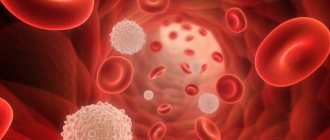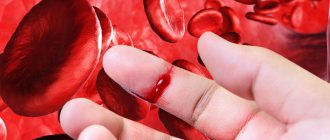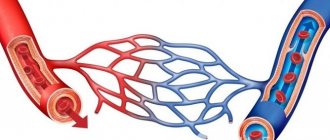Thrombocytopenia
– a pathological condition characterized by a decrease in the number of platelets per unit volume of blood and the resulting increased bleeding. Platelets play an important role in stopping bleeding. The molecules of the outer membrane of this flat blood element are able to recognize damaged areas of blood vessels and integrate into the structure of the capillaries, turning into a kind of “patch”. A decrease in the concentration of platelets in the bloodstream leads to a large number of pinpoint hemorrhages.
Classification of the disease
Thrombocytopenia has its own classification, based on a number of factors, symptoms and manifestations. The mechanism of the initiation and development of thrombocytopenia may be associated with the characteristics of the life cycle of blood platelets:
- decreased platelet formation in the red bone marrow.
- increased destruction of platelets.
- redistribution of platelets in the hematopoietic system due to inflammatory processes in the human body.
According to the etiology, primary and secondary thrombocytopenia are distinguished. First type
manifests itself as an independent disease.
The second type
is as a consequence of pathological abnormalities. Thrombocytopenia can have an acute and chronic course. The acute condition lasts a short time (up to 6 months) and is characterized by a vivid clinical picture. A chronic condition may occur with a gradual increase in symptoms. The severity of the disease depends on the number of platelets in the blood and is conventionally divided into three degrees - mild, moderate and severe. Each of them has its own manifestations - from frequent nosebleeds to hemorrhagic rash (purpura) and extensive bleeding into internal organs.
Severe course of transimmune thrombocytopenia in a newborn. Clinical observation
- Nikitina Irina Vladimirovna
- Lenyushkina Anna Alekseevna
- Balashova Ekaterina Nikolaevna
- Krogh-Jensen Olga Alexandrovna
- Morozov Leonid Andreevich
- Svirin Pavel Vyacheslavovich
- Vinogradova Maria Alekseevna
- Ageenkova Elina Viktorovna
- Lavrentieva Inna Nikolaevna
- Zubkov Viktor Vasilievich
- Degtyarev Dmitry Nikolaevich
Abstract
Transimmune thrombocytopenia (TIT) is a condition that often affects children born to mothers suffering from immune-mediated forms of diseases such as immune thrombocytopenia (formerly idiopathic thrombocytopenic purpura), systemic lupus erythematosus, hyperthyroidism, and lymphomas. The pathogenesis of the disease is due to the transplacental transfer of maternal antiplatelet antibodies to the fetus. According to the literature, the risk of neonatal TIT can reach 75%, but a clear relationship between the severity of immune thrombocytopenia in the mother and the severity of the disease in the newborn has not been identified. The article presents a literature review and clinical observation of a newborn with severe TIT.
Key words: thrombocytopenia, transimmune thrombocytopenia, transient thrombocytopenia of newborns, immune thrombocytopenic purpura, hematology, clinical observation
For citation
: Nikitina I.V., Lenyushkina A.A., Balashova E.N., Krog-Jensen O.A., Morozov L.A., Svirin P.V., Vinogradova M.A., Ageenkova E.V. , Lavrentieva I.N., Zubkov V.V., Degtyarev D.N. Severe course of transimmune thrombocytopenia in a newborn. Clinical observation // Neonatology: news, opinions, training. 2021. T. 7. No. 4. P. 45-52. doi: 10.2441l/2308-2402-2019-14005
Thrombocytopenia combines various nosological forms and syndromes in which there is a decrease in platelet count <150x109/l [1]. Thrombocytopenia is a fairly common hematological syndrome in the neonatal period: in 1-5% of children it is registered at birth, but only in 0.1-0.5% of newborns it occurs in a severe form (platelet count <50.0x109/l) [2, 3]. In approximately half of cases, thrombocytopenia manifests itself as hemorrhagic syndrome. The causes of thrombocytopenia in newborns are highly variable [4]. These may be primary thrombocytopenias, which, as a rule, are based on immunopathological processes or genetically determined conditions. Secondary (symptomatic) thrombocytopenia occurs against the background of various conditions, including viral or bacterial infections, severe hypoxic manifestations, immunodeficiency states, disseminated intravascular coagulation syndrome (DIC), etc. [5].
The mechanisms of development of thrombocytopenia in the neonatal period are different. Quite roughly they can be divided into the following groups:
■ Increased platelet consumption.
■ Mechanical destruction of platelets.
■ Insufficient platelet production.
■ Increased destruction of platelets as a result of immune processes.
Increased platelet consumption
observed in DIC, mechanical ventilation, thrombotic microangiopathies, in cavernous vascular formations (Kasabach-Merritt syndrome, other venous and arterial malformations and tumors).
Mechanical failure
platelet deficiency can develop with hypersplenism of various etiologies.
Insufficient platelet production may be:
■ isolated, for example amegakaryocytic thrombocytopenia;
■ in combination with other anomalies, for example TAR syndrome (thrombocytopenia and absence of the radius), thrombocytopenia and radial synostosis, Jacobsen's syndrome (thrombocytopenia, psychomotor retardation and facial abnormalities), DiGeorge syndrome (thrombocytopenia, congenital heart disease, facial abnormalities , thymus and parathyroid glands and deficits in cognitive functions), Wiskott-Aldrich syndrome (thrombocytopenia, immunodeficiency, eczema, lymphoma);
■ in combination with damage to other hematopoietic germs, for example Fanconi anemia (a condition accompanied by aplasia of both megakaryocyte and other hematopoietic germs, with various pigmentation disorders, congenital anomalies of the skeleton, eyes, ears, heart).
It should be noted that the mechanism of development of thrombocytopenia during intrauterine infection is complex and is associated with insufficient production of platelets by the bone marrow due to inhibition of the megakaryocyte lineage by pathogen toxins, hypersplenism, consumption in areas of endothelial damage, activation by bacterial toxins and the development of disseminated intravascular coagulation.
The development of thrombocytopenia in newborns is also promoted by a number of dosage forms prescribed to pregnant women: antihypertensives, thiazide drugs, hydralazine, sulfonamides, furazolidone, phenylbutazone, estrogens, heparins, etc.
Increased destruction of platelets is observed as a result of immune processes:
trans- and alloimmune thrombocytopenia.
The development of alloimmune thrombocytopenia is similar to hemolytic disease, however, the immunological conflict is caused by the incompatibility of the fetus and mother in platelet antigens (most often the PLM antigen, which is absent in the mother). Antiplatelet antibodies appear in the sensitized maternal body, which, penetrating the placenta, cause the destruction of platelets in the fetus.
Transimmune thrombocytopenia (TIT) occurs in children born to women with immune-mediated diseases [immune thrombocytopenic purpura (ITP), systemic lupus erythematosus, hyperthyroidism, lymphoma, etc.] [6]. The disease develops as a result of transplacental transfer of maternal antiplatelet antibodies (mainly IgG) and, possibly, a clone of sensitized lymphocytes, resulting in platelet sequestration and thrombocytopenia [7]. According to the literature, the risk of developing TIT in such newborns can reach 75%. A clear relationship between the severity of ITP in the mother and the severity of the disease in the newborn has not yet been identified [8, 9]. At the same time, 2 predictors have been identified that are associated with the development of severe neonatal thrombocytopenia: maternal splenectomy and the birth of a previous child with thrombocytopenia [8, 10, 11].
Several clinical variants of the course of TIT have been described [2, 5, 6, 10, 11]:
■ asymptomatic (presence of only laboratory signs of moderate thrombocytopenia without hemorrhagic syndrome. Usually spontaneous recovery by the end of 3-4 weeks of life);
■ early manifestation (hemorrhagic syndrome from the first days or even hours of life);
■ late manifestation (cutaneous hemorrhagic syndrome, usually debuting after 7-10 days of life). The likelihood of hemorrhagic manifestations directly correlates with the level of decrease in the number of platelets; a mild wave-like course of the disease lasting up to 3-5 months is typical with relapses of cutaneous hemorrhagic syndrome.
This article presents a clinical observation of severe TIT in a full-term newborn born at the National Medical Research Center for Obstetrics, Gynecology and Perinatology named after. acad. IN AND. Kulakov" of the Ministry of Health of Russia (National Medical Research Center of AGP named after Academician V.I. Kulakov) in a woman with chronic immune thrombocytopenia (cITP).
Clinical case
Patient G.,
31 years old, was observed in the Republic of Bashkortostan by a hematologist with a diagnosis of ITP, severe, complicated by hemorrhagic syndrome in the form of nasal and gingival bleeding. The onset of the disease was noted at the age of 24, when, against the background of isolated thrombocytopenia, increased bleeding of the gums and nosebleeds first appeared. In 2014, a bone marrow puncture was performed to clarify the diagnosis. The diagnosis of cITP was confirmed.
After confirmation of the diagnosis, glucocorticosteroid therapy was administered without significant effect (prednisolone 1 mg/kg per day - platelet count 14-37x109/l).
Further therapy included thrombopoietin receptor agonists - eltrombopag without effect and romiplostim with a partial positive effect.
The patient first applied to the National Medical Research Center for AGP named after. acad. IN AND. Kulakova is 16 weeks pregnant. The first pregnancy occurred spontaneously and proceeded against the background of the threat of miscarriage at 5-6 weeks.
At the time of admission to the National Medical Research Center of AGP named after. acad. IN AND. The Kulakova patient did not receive specific therapy for cITP for 5 months. A general blood test revealed thrombocytopenia up to 15x109/l. Clinically - manifestations of hemorrhagic syndrome in the form of a petechial rash on the skin of the trunk and limbs, as well as scanty bloody discharge from the nose, increased gingival bleeding. Taking into account the history and severe course of cITP, in accordance with current clinical guidelines [12], the pregnant woman was given a course of intravenous immunoglobulin (IVIG) (0.4 g per 1 kg of body weight) under the control of platelet count after administration on 2-3 days. e day. The dynamic platelet count is 70x109/l.
According to fetal ultrasound data at 18-19 weeks, there was a tendency towards oligohydramnios. At 25 weeks, signs of intrauterine infection of the fetus were diagnosed, for which the patient received antibiotic therapy at the place of residence. At a period of 26-27 weeks, the woman suffered a severe acute respiratory disease with a rise in body temperature to 38 ° C, was hospitalized, received antibiotic therapy, IVIG therapy enriched with class M immunoglobulins. Throughout the third trimester, she was under the supervision of specialists from the antenatal clinic. place of residence and took prednisolone daily. The platelet count at the time of delivery was 55x109/l.
The first spontaneous birth was at 38 weeks. A full-term girl was born weighing 3148 g, length 51 cm. The Apgar score was 8/8 points.
The condition during the initial examination was assessed as satisfactory; no petechiae or ecchymoses were detected. The child was transferred for further observation to the pediatric physiological department.
Considering the mother's complicated medical history, as well as the prednisolone therapy she received during the third trimester, the baby was not put to the breast, and artificial feeding was prescribed. At the age of 3 hours, the girl developed linear petechial rashes on the skin in the area of the right axilla, in the area of the pelvic bone on the right side of the back and at the insertion site of the head. In the perianal area, a vascular node of 0.5x0.5 cm was noted, without inflammatory changes along the periphery. When monitoring a clinical blood test, thrombocytopenia was revealed at 21x109/l, which, together with manifestations of cutaneous hemorrhagic syndrome, was the reason for transferring the child for further examination and treatment to the neonatal intensive care unit.
Considering the presence of respiratory disorders upon admission (due to transient tachypnea of newborns), the child was provided with non-invasive respiratory therapy using the NCPAP method, and did not require additional oxygen supplementation. Over time, respiratory disorders regressed, respiratory therapy was completed at the age of 3 days of life. Episodes of saturation lability and apnea were not observed. Differential diagnosis between transient tachypnea, RDS and congenital pneumonia, sepsis was carried out in accordance with generally accepted criteria [13, 14].
Taking into account the marked decrease in platelet count (21x109/l) and maternal medical history, thrombocytopenia was regarded as transimmune, which served as the basis for prescribing IVIG therapy [4]. On the first day of life, the child was given intravenous drips of immunoglobulin at a rate of 800 mg/kg.
Considering the lack of effect from the first administration of IVIG at a dose of 0.8 g/kg and persistent thrombocytopenia 11x109/l, it was decided to continue the course of IVIG therapy, the dose of the latter was increased to 1 g/kg.
According to the NSG performed on the 2nd day of life, the formation of subependymal hemorrhage could not be excluded, which required additional examination to exclude coagulopathies. When studying the coagulogram, plasma hemostasis was compensated. There were no indications for transfusion of fresh frozen plasma.
Considering the high risk of intracranial hemorrhage and the low effectiveness of standard IVIG therapy, transfusion of platelet concentrate 0(I) Rh positive (+) was performed for health reasons.
The child was also examined for TORCH complex infections, the result was negative.
In dynamics, when monitoring a clinical blood test on the 3rd day of life, a pronounced decrease in the number of platelets (5x109/l) remained, according to the control NSG - without focal changes, no data for IVH were obtained.
The lack of increase and continued decrease in the number of platelets after transfusion of platelet concentrate also indicated the immune genesis of thrombocytopenia and became the basis for continuing the course of IVIG therapy. Further monitoring of the clinical blood test revealed persistence of thrombocytopenia 14-6x109/l. According to the NSG, no negative dynamics.
From the 7th day of life, a slight positive trend was noted for the first time in the clinical blood test: the number of platelets increased to 21x109/l. However, later, on the 11th day, when the umbilical cord fell off, short-term minor bleeding was noted, which stopped on its own (Fig. 1).
No disturbances in plasma hemostasis were noted. NSG dynamics - without deviations. On the 12th day of life, he was routinely examined by a neurologist - no pathological neurological symptoms were identified.
In view of long-standing thrombocytopenia, the feasibility of studying bone marrow hematopoiesis was discussed. Taking into account the positive dynamics of thrombocytopenia and the potential risk of invasive interventions, it was decided to temporarily refrain from bone marrow puncture for the child, who is in a stable clinical condition. The child’s condition remained stable from the 14th to the 18th day, however, on the 19th day of life, elements of a petechial rash appeared in the neck and areas where clothing was attached (Fig. 2).
Repeated transfusion of platelet concentrate and the 6th administration of IVIG (course dose 5.8 g/kg) were performed. The results of an additional examination of the child were received: the number of reticulocytes, schizocytes is within the normative values, the Coombs test is questionable, LDH is within the normal range, there are no markers of infection, PCR (bacterial, fungal and viral screening), TORCH infections using ELISA - the result is negative. The relative content of platelet-associated antibodies in the mother’s blood was recorded high - 290% of the control (norm up to 200%), the child was also increased - 270% of the control (norm up to 200%), the concentration of glycocalycin in the mother and child without deviations from the reference values . The results obtained indicated the absence of disturbances in platelet production in the bone marrow and the transimmune nature of thrombocytopenia in the child.
The newborn was monitored dynamically by a hematologist. Despite the fact that anamnestic and clinical laboratory data indicated the transimmune nature of thrombocytopenia, the lack of effect from standard TIT therapy required the exclusion of amegakaryocytic thrombocytopenia in the child before prescribing glucocorticosteroid (GCS) therapy, and therefore a myelogram study was recommended, from which relatives in the neonatal period was categorically refused.
In a stable serious condition without neurological and respiratory disorders, with single elements of a petechial rash in the area of the anterior surface of the neck in the stage of reverse development, as well as with single petechial elements on the skin of the anterior abdominal wall in places of friction with clothing against the background of thrombocytopenia 20-28x109/l child was transferred from the neonatal resuscitation and intensive care unit to the pathology department of newborns and premature infants.
On the 21st day of life, a significant decrease in the number of platelets was again recorded (to 2.9x109/l), hematomas were clinically noted at the injection site, and there was no spontaneous bleeding. According to the ophthalmologist's report, retinal hemorrhages on both sides were detected more than 3 days ago. On the 26th day of life, severe thrombocytopenia persisted without a tendency to increase since birth.
The dynamics of the platelet count during IVIG therapy and platelet concentrate transfusions is presented in Fig. 3.
For further examination and treatment, the child was transferred to the hematology department of the Morozov Children's City Clinical Hospital of the Moscow Department of Health. Upon admission: the condition was of moderate severity, cutaneous hemorrhagic syndrome was minimal, represented by single petechiae on the trunk and limbs in places of mechanical pressure. There are no symptoms of intoxication, lymphadenopathy, or hepatosplenomegaly. Upon admission, a clinical blood test revealed isolated thrombocytopenia up to 30x109/l. According to the results of the myelogram: significant irritation of the megakaryocyte lineage (1:50 cells) with sluggish “detachment” of platelets, which indicates in favor of the diagnosis of “ITP”.
Considering the ineffectiveness of previous therapy, standard GCS therapy with methylprednisolone at a dose of 3 mg/kg per day was started for immunosuppressive purposes [15]. On the 6th day of GCS therapy, complete clinical and hematological remission of immune thrombocytopenia was achieved. The hemorrhagic syndrome was completely relieved, the platelet count returned to normal - 219x109/l. The child was discharged home in satisfactory condition under the supervision of a hematologist to continue therapy on an outpatient basis.
The dynamics of the number of platelets in a newborn over the entire observation period during therapy is presented in Fig. 4.
Consistent and thorough implementation of all stages of the diagnostic search made it possible to obtain a clear understanding of the pathogenesis of thrombocytopenia in a newborn, formulate a diagnosis and develop the correct treatment tactics. It should be noted that the differential diagnosis of thrombocytopenia in newborns is a complex process, the competent implementation of which largely determines the success of therapeutic measures, and, consequently, the prognosis and quality of life of the patient.
Rational therapy for transimmune and other neonatal thrombocytopenia continues to be debated and cannot be considered sufficiently studied. The least controversial is the use of IVIG. The effectiveness of this method has been proven. The positive effect of IVIG in the immune form of thrombocytopenia is due to the blockade of Fc receptors of macrophages, which reduces opsonization of platelets and prevents their destruction in the bloodstream [16].
The use of platelet concentrate transfusion requires a careful and balanced approach. Antigens on the membrane of injected donor platelets are quickly blocked by circulating antibodies, which significantly reduces the duration of their effective work. In general, transfusion of platelet concentrate to patients with immune-mediated thrombocytopenia is likely to further aggravate the process [15]. At the same time, there is reason to believe that transfusion of platelet concentrate can be effective in stopping bleeding that has already begun.
In our observation, the patient, despite IVIG therapy, continued to have severe thrombocytopenia. A positive therapeutic effect was achieved in the 2nd month of the child’s life only after a course of high-dose hormonal therapy, which, apparently, is associated precisely with the phenomenon of transplacental transfer of a sensitized lymphocyte clone. At the same time, timely use of IVIG and platelet transfusion allowed us to avoid significant hemorrhagic syndrome.
The issue of the use of glucocorticosteroids as part of the treatment of transimmune thrombocytopenia in newborns born to women suffering from ITP is currently controversial. The mechanism of action of prednisolone in newborns with TIT differs from that of ITP itself and, apparently, consists of inhibition of the process of phagocytosis. Prednisolone reduces the expression of Fc receptors on macrophage membranes and blocks the intracellular mechanisms of activation of leukocytes and macrophages. This blocks the contact of phagocytic cells with antiplatelet antibodies on the platelet surface and therefore prevents platelet elimination [16, 17]. It can also be assumed that the synthesis of antibodies triggered by the clone of sensitized lymphocytes that arrived transplacentally decreases.
There are no randomized controlled studies on the treatment of GCS in newborns with TIT, and therefore, there are currently no uniform treatment protocols [18]. The most large-scale scientific studies in this area are retrospective, they were carried out in the Netherlands and Turkey. The results obtained during the research are descriptive in nature. In the work of van Der Lugt et al. (2013, the Netherlands) [10] analyzed the outcomes and treatment of newborns from mothers with ITP from 1980 to 2011 ( n
=67): severe thrombocytopenia (<50x109/l) was observed in 29.9% (
n
=20) of newborns and in most cases occurred without clinical manifestations (petechial rash in 3% of cases).
The average duration of thrombocytopenia was 11 days (3-58). Treatment was required in 26.8% ( n
=18) of neonates with thrombocytopenia.
In this case, there were no severe hemorrhagic manifestations. A drop in platelet count <20x109/L was recorded in only 12% ( n
= 8) of patients over the entire 30 years of observation.
Immunoglobulin therapy in combination with platelet concentrate transfusion was carried out in 18% of newborns, prednisolone in combination with platelet concentrate transfusion was carried out in 4.4% of children. Isolated therapy with prednisolone - 3% ( n
= 2) of patients. The results obtained allowed the authors to conclude that IVIG therapy is effective in most cases. Treatment with prednisolone was not brought up for discussion due to limiting factors that are stated by all experts in this field: the rarity of severe transimmune thrombocytopenia, the lack of a uniform treatment protocol and an extremely small group of newborns who received only GCS therapy [10].
In a study by T. Bayhan et al. (2016) [8] analyzed 20 years of experience in managing newborns from mothers with ITP for 1994-2014. The retrospective analysis included 36 newborns. Thrombocytopenia was observed in 55.5% ( n
=20) of them, while in 27.7% (
n
=10) of cases there was a significant decrease in the platelet count (<50x109/l).
Clinical manifestations of hemorrhagic syndrome were observed in 8.3% ( n
= 3) of newborns.
Treatment with prednisolone alone was carried out in 5.5% (2) of newborns, in combination with immunoglobulin - 8.3% ( n
= 3).
Administration of immunoglobulin (isolated and/or in combination with transfusion of platelet concentrate and/or corticosteroids) occurred in 27.7% ( n
= 10) of children. The authors of both studies conclude that immunoglobulin therapy is effective, noting that early administration of IVIG prevents platelet breakdown and reduces the need for transfusion of platelet concentrate. An increase in platelet count (>50x109/l) is not observed immediately after transfusion of platelet concentrate, while the effect of immunoglobulin administration occurs on average within 1-2 days. Long-term thrombocytopenia (>4 weeks) in newborns from mothers with ITP in a study by T. Bayhan et al. described in 1 (2.7%) child out of 36.
It was previously thought that severe complications of TIT in the form of intracranial hemorrhage were rare (<1% of cases), but according to the most recently published study in 2021, which analyzed 23 cases of TIT from 2007 to 2021, the incidence of intracranial hemorrhage is 4 .3% ( n
=1).
Also noteworthy is the fact that the reported incidence of thrombocytopenia in newborns from mothers with ITP in this study is slightly higher and amounts to 74% ( n
= 17) [11].
Thus, if newborns with TIT have long-lasting severe thrombocytopenia, refractory to IVIG transfusion, the use of GCS as part of complex therapy may be justified from the point of view of reducing the risk of hemorrhagic syndrome, especially in severe intracranial hemorrhages.
In view of the significant rarity of this disease and the lack of uniform global approaches to the treatment of refractory forms of TIT, it is extremely important to continue fundamental research aimed at a deeper study of the mechanisms of the damaging effects of antibodies and other immune agents on platelets of the fetus and newborn, as well as conducting multicenter studies for a comparative analysis of the effectiveness of various TIT therapy regimens.
Conflict of interest
. The authors declare no conflict of interest.
Literature
1. Barkagan Z.S. Hemorrhagic diseases and syndromes. 2nd ed., revised. and additional M.: Medicine, 1988. 528 rub.
2. Maschan A.A., Rumyantsev A.G. Immune-mediated thrombocytopenia in newborns: differential diagnosis and principles of therapy // Issues. hematology/oncology and immunopathology in pediatrics. 2010. T. 9, no. 3. pp. 13-18.
3. Pshenichnaya K.I. Congenital thrombocytopathies in children: features of diagnosis, symptoms and treatment: abstract. dis. ...Dr. med. Sci. St. Petersburg, 2002. 28 r.
4. Volodin N.N. Neonatology: national guide. M.: GE-OTAR-Media, 2009.
5. Sudakova N.M. and others. Theoretical and clinical aspects of thrombocytopenia in newborns // Lech. doctor. 2012. No. 2. P. 73-76.
6. Roberts I., Stanworth S., Murray NA Thrombocytopenia in the neonate // Blood Rev. 2008. Vol. 22, N 4. P 173-186.
7. Zakirov I.I., Safina A.I. Thrombocytopenia of newborns. Clinical lecture // Vestn. let's modernize wedge. honey. 2013. T. 6, no. 6. pp. 102-107.
8. Bayhan T. et al. Neonates born to mothers with immune thrombocytopenic purpura: a single-center experience of 20 years // Blood Coagul. Fibrinolysis. 2021. Vol. 27, N 1. P. 19-23.
9. Castle V. et al. Frequency and mechanism of neonatal thrombocytopenia // J. Pediatr. 1986. Vol. 108, N 5. Pt 1. P. 749-755.
10. van der Lugt NM et al. Outcome and management in neonatal thrombocytopenia due to maternal idiopathic thrombocytopenic purpura // Vox Sang. 2013. Vol. 105, N 3. P. 236-243.
11. Karakurt N. et al. Neonates born to mothers with immune thrombocytopenia: 11 years' experience of a single academic center //
Blood Coagul. Fibrinolysis. 2021. Vol. 29, N 6. P. 546-550.
12. Melikyan A.L. and others. National clinical guidelines for the diagnosis and treatment of primary immune thrombocytopenia (idiopathic thrombocytopenic purpura) in adults // Hematol. and transfusiol. 2015. T. 60, No. 1. P. 44-56.
13. Ionov O.V. etc. The procedure for examining newborns with suspected infectious pathology and the rules for prescribing antibacterial therapy adopted in the neonatal intensive care unit of the Federal State Budgetary Institution “Scientific Center for Obstetrics, Gynecology and Perinatology named after V.I. Kulakov” of the Ministry of Health of Russia // Neonatology: news, opinions, training. 2014. No. 1. P. 95-106.
14. Golubtsova Yu.M., Degtyarev D.N. Modern approaches to the prevention, diagnosis and treatment of early neonatal sepsis // Neonatology: news, opinions, training. 2014. No. 2. P. 15-25.
15. Maschan A.A., Rumyantsev A.G. Federal clinical guidelines for the diagnosis and treatment of immune thrombocytopenic purpura in children. M., 2015.
16. Zufferey A., Kapur R., Semple JW Pathogenesis and therapeutic mechanisms in immune thrombocytopenia (ITP) // J. Clin. Med. 2021 Vol. 6, N 2. P 16.
17. Jones CJP, Morris KJ, Jayson MIV Prednisolone inhibits phagocytosis by polymorphonuclear leucocytes via steroid receptor mediated events // Ann. Rheum. Dis. 1983. Vol. 42, N 1. P 56-62.
18. Dixon H. Nottingham Neonatal Service - Clinical Guidelines. No. E7. Neonatal Thrombocytopenia. Version: 4. Date: July 2021.
Causes of thrombocytopenia
Among the various reasons causing this serious disease, the main ones are:
Symptoms of thrombocytopenia
The clinical picture of thrombocytopenia depends on the cause of this pathology, as well as the severity of the disease. The main signs are multiple hemorrhages on the skin, as well as spontaneous bleeding - nasal, pulmonary, uterine. Other manifestations of the disease:
Causes and symptoms
There are many causes of thrombocytopenia during pregnancy.
The most common ones include:
- hormonal changes - occur against the background of developing pregnancy;
- an increase in the amount of blood circulating through the vessels;
- lack of vitamin B12 in the body;
- condition of eclampsia;
- the presence of viral infections in the acute or latent phase;
- overactive immune system;
- tendency to allergic reactions;
- placental abruption and internal bleeding;
- intrauterine death of a child;
- taking antibiotic drugs.
The initial stages of the disease do not have characteristic symptoms.
More severe forms are easy to diagnose by external signs:
- the appearance of bruises on the body for no apparent reason;
- spontaneous nosebleeds;
- bleeding gums;
- the appearance of hemorrhoids and anal fissures;
- small subcutaneous hemorrhages in the form of dots;
- uterine and vaginal bleeding.
Cost of consultation for thrombocytopenia?
| Name of service | Price, rub.) |
| Initial appointment with a cardiologist | 1800 rub. |
| Repeated appointment with a cardiologist | 1300 rub. |
| Primary appointment with a general practitioner | 1800 rub. |
| Repeated appointment with a general practitioner | 1300 rub. |
| Prescription of treatment (drawing up an individual treatment regimen) | 1000 - 2500 rub. |
All our services and prices
Diagnosis and treatment
Increased bleeding
– a reason to immediately seek advice from a specialist (hematologist), who will take a detailed medical history and prescribe the necessary examinations. The main diagnostic method is a clinical blood test, which determines the quantitative composition of platelets. The patient may also be recommended a bone marrow puncture to assess the quality of this type of hematopoiesis, ultrasound of the spleen, chest x-ray, and tests for the presence of antibodies. During pregnancy, thrombocytopenia is diagnosed using a coagulogram (blood clotting test), which allows one to determine the quantitative composition of platelets in a woman’s blood.
A serious disease such as thrombocytopenia should be treated only under the supervision of a doctor. After receiving the results of all examinations, the specialist selects individual therapeutic measures for each patient. Severe hemorrhagic syndrome requires urgent hospitalization and emergency care. For severe bleeding, platelet transfusions are indicated, and angioprotectors and fibrinolysis inhibitors are prescribed. Avoid taking acetylsalicylic acid and anticoagulants. If there is a deficiency of vitamin B12 or folic acid, medications with a high content of these elements are prescribed. This significantly improves the general condition of the patient and the results of his tests. If immune thrombocytopenia is diagnosed, a course of prednisolone will be required. The dosage is determined by the individual characteristics of the patient and his body. If drug therapy is ineffective and repeated bleeding occurs, splenectomy (removal of the spleen) is indicated. For non-immune thrombocytopenia, symptomatic hemostatic therapy is recommended.
There is no special diet for thrombocytopenia, but you should adhere to the principles of a rational, balanced diet. You should introduce more vegetables, fruits, herbs, low-fat dairy products, vegetable oils, legumes, and seafood into your diet. Alcohol consumption is strictly prohibited. Undesirable foods: white rice, sugar, baked goods, marinades and pickles.
After consulting with your doctor, you can use traditional medicine - infusions and decoctions of medicinal herbs, sesame oil.
Therapy methods
Treatment of thrombocytopenia during pregnancy consists of the following factors:
- regular monitoring of blood status;
- taking medications;
- compliance with the rules of a healthy lifestyle.
Such complex therapy gives a guaranteed positive result.
Thrombocytopenia at the initial stage of development does not require drug treatment. In such cases, the woman’s condition is only controlled.
If the pathology progresses, it is necessary to take medications. Their action is aimed at increasing blood density and increasing platelet concentration.
Self-medication and the use of traditional medicine recipes are not recommended.
A low platelet concentration is an extremely dangerous condition that can threaten the life of a woman and child.









